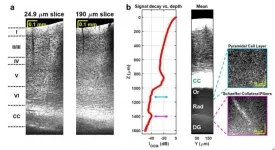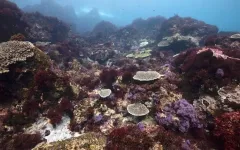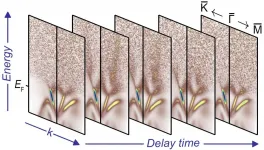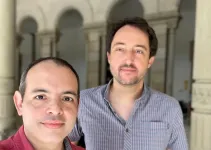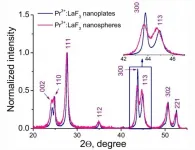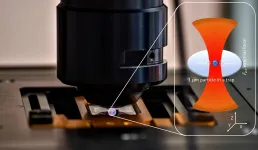Scientists get to the bottom of deep Pacific ventilation
2021-07-16
(Press-News.org) The team's findings, with important implications for ocean biogeochemistry and climate science, have been published by Nature Communications in a paper by Associate Professor Mark Holzer from UNSW Science's School of Mathematics & Statistics, with co-authors Tim DeVries (UCSB) and Casimir de Lavergne (LOCEAN).
"The deep North Pacific is a vast reservoir of remineralized nutrients and respired carbon that have accumulated over centuries," says A/Prof. Holzer. "When these deep waters are returned to the surface, their nutrients support biological production and their dissolved CO2 can be released into the atmosphere. As such, the deep Pacific plays a key role in the earth's climate system."
But what are the pathways of the ocean circulation that supply newly ventilated surface water to the deep Pacific? And how and where does this old water eventually return to the surface? To date, there were two competing theories for the role that the overturning circulation plays in this.
One theory - the 'standard conveyor' - envisions broad overturning with Antarctic Bottom Water upwelling to around 1.5 km depth before flowing back south to the Southern Ocean. The other theory - the 'shadowed conveyor' - argues that the overturning is compressed to lie below about 2.5 km with a largely stagnant "shadow zone" above it.
"Our work reconciles these two theories: the shadowed conveyor correctly captures vertically compressed overturning beneath a shadow zone, while the standard view must be broadly interpreted in terms of water paths diffusing through the shadow zone. Because the shadow zone is largely shielded from the overturning circulation the question becomes how exactly does water get into and out of it," A/Prof. Holzer says.
Using novel mathematical analyses applied to a state-of-the-art ocean circulation model that optimally fits the circulation to observed tracer distributions and surface forcings, the authors were able to quantify in detail the pathways and timescales with which the shadow zone exchanges water with the surface ocean.
"Our analyses allowed us to come up with a new schematic of the large-scale deep circulation in the Pacific. We find that diffusive transport both along and across density surfaces plays a leading role in ventilating the shadow zone."
Contrary to the widely held view that Pacific deep waters exclusively follow density surfaces to upwell in the Southern Ocean, the authors found that only about half of the water in the shadow zone follows this route, with the other half returning to the surface in low latitudes and in the subarctic Pacific, helping to explain the high biological production there.
The scientists say this new understanding of the deep Pacific circulation and transport pathways will help interpret observed tracer distributions and biogeochemical processes.
"An exciting direction for future research is to understand how the shadow zone, already low in oxygen and sensitive to increased oxygen demand, shapes the response of the ocean's biological pump to climate change," A/Prof. Holzer says.
INFORMATION:
ELSE PRESS RELEASES FROM THIS DATE:
2021-07-16
Central nervous system (CNS) diseases such as Alzheimer's disease (AD) manifest early at the microscopic (i.e. cellular) level, deep in the brain. Yet, optical microscopes that can see cells in the living brain are superficial or invasive. Whole brain imaging techniques such as magnetic resonance imaging are deep and non-invasive, but lack cellular resolution.
In a new paper published in Light Science & Application, a team of scientists, led by Professor Vivek J. Srinivasan from the Departments of Ophthalmology and Radiology and Tech4Health Institute, ...
2021-07-16
Shizuoka, Japan - At Shikine Island, Japan, kelp forests and abalone fisheries were once common, but over the last twenty years they have disappeared. Now, researchers from Japan have discovered that these temperate coastal marine ecosystems are becoming more "simple", losing biodiversity, complexity and their aesthetic values.
In a study published this month, researchers from the University of Tsukuba and international collaborators explored how the combined effects of ocean warming and acidification are changing temperate coastal marine ecosystems.
Tropical coastal seas are synonymous with coral reefs. As ocean temperatures cool toward the poles, corals give way to kelp as the main habitat-forming species. The shift from coral to kelp can clearly be seen along the 2000 km ...
2021-07-16
The laws of quantum physics rule the microcosm. They determine, for example, how easily electrons move through a crystal and thus whether the material is a metal, a semiconductor or an insulator. Quantum physics may lead to exotic properties in certain materials: In so-called topological insulators, only the electrons that can occupy some specific quantum states are free to move like massless particles on the surface, while this mobility is completely absent for electrons in the bulk. What's more, the conduction electrons in the "skin" of the material are necessarily spin polarized, and form robust, metallic surface states that could be utilized as channels in which to drive pure spin currents on femtosecond ...
2021-07-16
An international research team led by YAO Zhonghua from the Institute of Geology and Geophysics of the Chinese Academy of Sciences (IGGCAS) has explained the cause of Jupiter's X-ray aurorae, a mystery that has puzzled scientists for 40 years.
The findings were published in Science Advances on July 9.
It is the first time planetary researchers have described the entire causality chain for Jupiter's X-ray auroral flares. The mechanism in producing X-ray auroral flares at Jupiter may have potential applications in X-ray astronomy.
The X-ray auroral spectra tell us these aurorae are produced by heavy ions with energies in the ...
2021-07-16
From the vocal cords that produce our voice, to our heartbeat, our body's cells are constantly subjected to mechanical forces that steadily change their response to these stimuli, regulating vital processes, in healthy individuals and in diseases such as cancer alike. Nevertheless, despite their importance, we remain largely ignorant of how cells sense and respond to these forces.
Now, an international team co-led by the researcher Pere Roca-Cusachs, from the Institute for Bioengineering of Catalonia (IBEC), and Isaac Almendros, a researcher at the Respiratory Diseases Networking Biomedical Research Centre (CIBERES) and IDIBAPS, both professors at the Faculty of Medicine and Health Sciences of the University of Barcelona (UB), has proved that what determines mechanical ...
2021-07-16
The article represents the transmission electron microscopy (TEM) and flow cytometry study of A-549 (human lung carcinoma) cellular uptake of Pr3+:LaF3 nanoparticles. The Pr3+:LaF3 nanoparticles are promising platforms for cell nano-sensors.
The objective of the work was to study the influence of nanoparticle morphology (nanoplates and nanospheres) on cytotoxicity and the dynamic of cellular uptake.
In the flow cytometry method, the cells go through a small tube (as a flow) and are irradiated by a laser. Cells scatter the laser light, and this scattering ...
2021-07-16
Measurements of biomechanical properties inside living cells require minimally invasive methods. Optical tweezers are particularly attractive as a tool. It uses the momentum of light to trap and manipulate micro- or nanoscale particles. A team of researchers led by Prof. Dr. Cornelia Denz from the University of Münster (Germany) has now developed a simplified method to perform the necessary calibration of the optical tweezers in the system under investigation. Scientists from the University of Pavia in Italy were also involved. The results of the study have been published in the journal Scientific Reports.
The calibration ensures that measurements of different samples and with different devices are comparable. ...
2021-07-16
The ability to predict and interpret modifications of ribonucleic acid (RNA) has been a welcome advance in biochemistry research.
However, existing predictive approaches have a key drawback--they can only predict a single type of RNA modification without supporting multiple types or providing insightful interpretation of their prediction results.
Researchers from Xi'an Jiaotong-Liverpool University, led by Dr Jia Meng, have addressed this issue by developing a model that supports 12 RNA modification types, greatly expanding RNA research prediction and interpretation.
"To the best of our knowledge, ...
2021-07-16
While tropical forests remain threatened and their future is uncertain, the importance of understanding how well individual protected areas avoid deforestation increases. Researchers from the University of Turku and University of Helsinki, Finland, have investigated this question in a newly published study that focuses on the State of Acre in Brazilian Amazonia.
Tropical forests are unique environments that have huge species diversity and also act as important reservoirs of organic carbon, thereby counteracting climate change. However, their area is diminishing due to deforestation, ...
2021-07-16
Tsukuba, Japan - A team of scientists led by Associate Professor Haruka Ozaki of the Center for Artificial Intelligence Research at the University of Tsukuba in collaboration with Dr. Koichi Takahashi from RIKEN used mathematical algorithms to optimize the schedule of automated biology laboratory robots. By analyzing the needs of time-sensitive samples that require investigation using multiple instruments, the researchers were able to maximize the number of experiments that can be performed within time and laboratory resource constraints. This work may help in the design of future automated biology labs and other workspaces.
Biology laboratories have seen increasing automation because many tasks, like pipetting solutions or moving cells from one ...
LAST 30 PRESS RELEASES:
[Press-News.org] Scientists get to the bottom of deep Pacific ventilation
